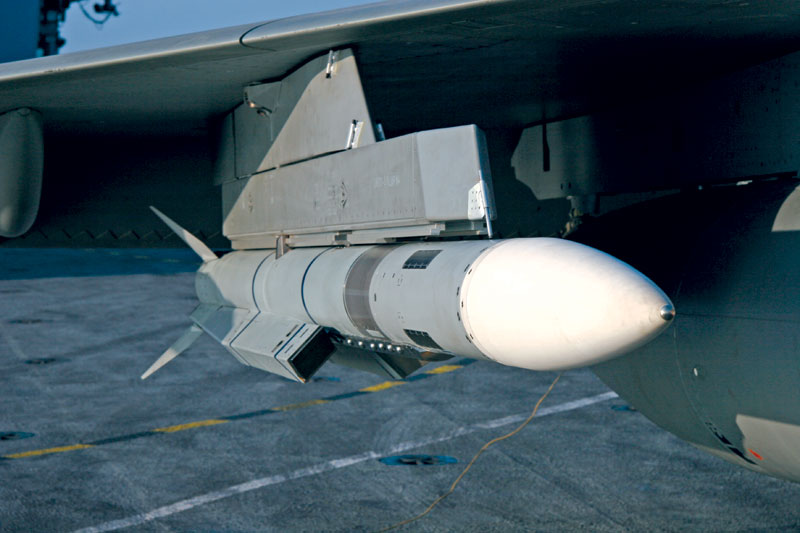MBDA’s Meteor BVR missile and MICA NG will be a part of the first six Rafale fighter jets being delivered by 27 July 2020
Palak Gupta
The Meteor Beyond Visual Range (BVR) air-to-air missile, which has already been integrated onto the Rafale aircraft, is widely recognised as a game changer for air combat. It is powered by a unique rocket-ramjet motor. This give the Meteor, as MBDA spokesperson explained to FORCE, “far more engine power, for much longer, than any other missile and this means it can fly faster, fly longer, and manoeuvre more than any other missile—giving Meteor the ability to chase down and destroy agile hostile fighters at even the furthest of ranges.” explained MBDA spokesperson.

To maximise its lethality, the missile is equipped with both an impact and a proximity fuse in addition to the blast fragmentation warhead. MBDA’s Meteor and Scalp cruise missile are fundamentally essential constituents of the weapons package of the 36 Rafale jets being procured by India at a cost of Rs 59,000 crore. The long-range stand-off Scalp has been part of the British Royal Air Force and the French Air Force and was also used in the 1991 Gulf War.
The Meteor BVR missile was developed using the technical expertise of six European nations—the UK, France, Germany, Italy, Spain and Sweden—that operate the missile today, and according to the company, India will be the only nation in the region to use Meteor, with “none of India’s neighbours being able to rival the operational performance the Indian Air Force (IAF) will have with Meteor.”
The BVR missile is also integrated on fighter aircraft including Eurofighter Typhoon, Gripen and will be integrated to the F-35 Lightning II Joint Strike Fighter.
Meteor’s network centric capability is achieved through the weapon’s datalink communication. Meteor can be operated using a third-party target data, enabling the air crew to have the most flexible weapon system.
In response to a question on Meteor’s kill probability and its two-way data link and active radar target seeker, MBDA spokesperson said that during Meteor’s flight mid-course, Rafale can provide updated target information to the missile via the datalink, after which Meteor’s advanced active radar seeker activates to track down its target in the end-game, even amid electronic jamming.
“These features, combined with the unique propulsion of Meteor’s rocket-ramjet engine are what give Meteor a no-escape zone many times higher than any other air-to-air missile,” the company added.
Enhancing Rafale’s strike capability
The Rafale can carry out both air-to-ground strikes as well as air-to-air attacks and interceptions during the same sortie. According to Dassault Aviation, the fighter jet is capable of performing several actions at the same time, such as firing air-to-air missiles during a very low altitude penetration phase.
India had signed an inter-governmental agreement (IGA) with France in September 2016 for procurement of 36 Rafale fighter jets at a cost of around Rs 58,000 crore. The first six of the 36 Rafale jets are expected to land in India by 27 July 2020. Earlier the jets were scheduled to arrive in India by the first week of May. The Covid-19 outbreak, however, ended up delaying the delivery timeline.
The first squadron of the aircraft will be stationed at Ambala air force station branded as one of the most strategic airbases of the country. The second squadron of Rafale will be stationed at Hashimara base in West Bengal.
According to media reports, besides the missile systems, the Rafale jets will come with various India-specific modifications, including Israeli helmet-mounted displays, radar warning receivers, low band jammers, 10-hour flight data recording, infra-red search and tracking systems among other specifications. The Rafale fighter jet has been in service with the French military since 2004. India is the fourth country to procure these jets after France, Qatar and Egypt.
MICA Next Generation (NG)
Another air to air missile MICA, which is being delivered for the IAF’s Mirage 2000 upgrade and is also a part of the weapon system of Rafale jets, is the only missile in the world featuring two interoperable seekers (active radar and imaging infrared) to cover the spectrum from close-in dogfight to beyond visual range.
In November 2019, according to the European missile maker firm MBDA, a programme was launched to develop the next generation of MICA, to include new seekers and a new propulsion system, and this programme is ‘progressing well’. It is expected to be ready by 2026.
The MICA NG will replace MICA missiles currently operational in service with the French armed forces and exported to 14 countries worldwide including India. In 2012, India purchased 450 MICAs as a part of the Mirage 2000 upgrade deal from France for USD1.23 billion.
According to the missile major MBDA, “The unique concept that has ensured the ongoing success of MICA for two decades remains: the option of two different seekers (infrared and radio frequency) and two launch modes (rail and ejection) in a single missile casing.”
And now the upgraded NG programme includes an extensive redesign of the current MICA family while keeping the same aerodynamics, mass and centre of gravity. This is done to minimise the amount of adaptation required to operate the new system with existing platforms and launchers.
You must be logged in to view this content.

